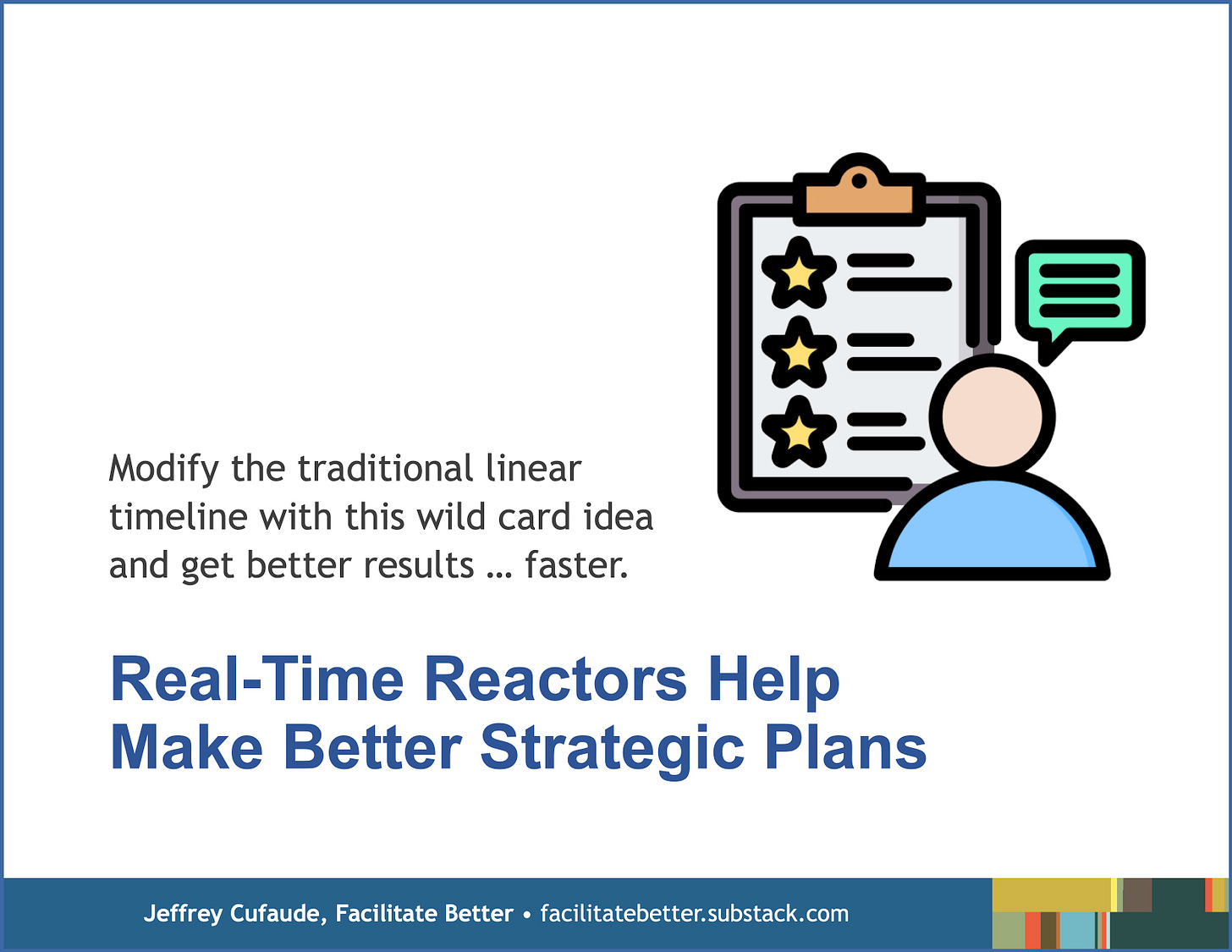Real-Time Reactors Make Better Strategic Plans (Facilitation Friday #56)
Disrupt the traditional planning timeline for better—and faster—results.
In many traditional strategic processes, a small group convenes and drafts a plan, later shares it for feedback, and then often reconvenes (sometimes months later) for revisions. Facilitators looking to condense this laborious and slow timeline (and likely improve on the initial draft) might wish to consider a wild-card idea that I call “Real-Time Reactors.”
What is the role of Real-Time Reactors?
Reactors are invited individuals who agree to provide feedback to the strategic planning group’s real-time output at one or more pre-determined points during the actual planning session (such as mid-day or end of day one of a multiple-day planning retreat).
Who are Real-Time Reactors?
In working with a planning group to determine whose reactions to seek, I usually pose this question: Whose real-time feedback on draft output might be most helpful to produce the most strategic direction and decisions?
Responses usually include individuals belonging to one or more of the following categories:
people (both internal and external to the organization) known for innovative and strategic thinking
everyone with certain functional roles in an organization (i.e. everyone in a management position or all committee and task force chairs)
past presidents, board chairs, or other individuals having significant history and engagement with the organization
everyone who meets a certain demographic (i.e., new customer within the last 12 months, new employees within the last 12 months; and/or
respondents to an open call for anyone interested in offering feedback
How are Real-Time Reactors engaged?
Using Real-Time Reactors can seem logistically challenging, but it really is quite simple. I commonly have the strategic planning group prepare a one- or two-page summary of its work so far in a session and post it online at a predetermined time (i.e., during the lunch break). This summary is also quite useful for them as it highlights the progress made so far. You may wish to experiment with AI applications like Otter.ai that can generate such summaries in real-time.
Reactors—who are instructed when and where to go online—review the output and respond to specific questions the group poses (usually a combo of a few polling questions and a few open-ended feedback questions). To facilitate the group’s development of these questions I use this prompt: What real-time feedback on draft output would be most helpful to produce the most strategic direction and decisions?
How does the planning group use the feedback gathered?
When the planning participants reconvene, Reactor feedback is reviewed and discussed. In some cases, it might be useful for the strategy session participants to actually speak with select Reactors (i.e., key customers or stakeholders, association past presidents, etc.) and engage in some conversation about their perceptions of the group’s work.
I find planning session participants often reference and apply Reactor feedback as the strategy discussions continue. Sometimes they may need reminding that Reactor feedback, while useful, is not necessarily universal truth or the guaranteed reaction of all other stakeholders.
A variation on reactors being remote
You might consider having a strategic sampling of the invited Reactors attend the discussions in-person and essentially fishbowl the process. At pre-determined moments, they share what they notice about the group’s conversations, as well as react to the output using the criteria the group has specified.
Bottom Line
Any strategy effort benefits from including diverse individuals and perspectives that can inform participant discussions and decisions. Real-Time Reactors can help expose planning session participants to additional ideas, insights, mindsets and experiences that may differ from their own. Obtaining this feedback and input in real-time from relevant stakeholders can improve plan drafts and accelerate development of the final strategic output.
Getting in Action
On your own or with a few colleagues, brainstorm a short list of people you would definitely invite to be Real-Time Reactors for any strategy development your organization might do in the future.
Identify other ways you might accelerate and improve upon the traditional linear strategic plan development timeline of release a draft, gather feedback, review input, revise plan.
Draft your own survey questions to gather input you think would be helpful to receive from Real-Time Reactors about a draft plan. Rather than starting from scratch, you could use this as a first draft with an actual group, asking them to revise as desired.
© Facilitate Better and Jeffrey Cufaude. All rights reserved.
To affordably license this content for reprint on your site or in electronic or print communications or to contact me regarding customized facilitation skills workshops or consultations, complete this form.


